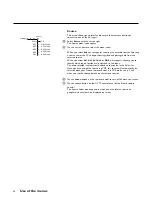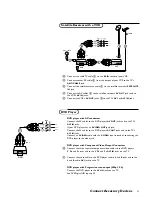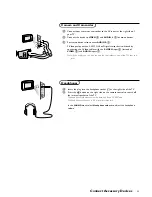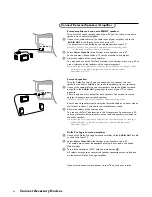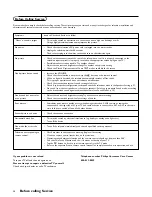
39
Tips & Index
This equipment has been tested and found to comply with the limits
for a Class B digital device, pursuant to part 15 of the FCC Rules.
These limits are designed to provide reasonable protection against
harmful interference in a residential installation.This equipment
generates, uses, and can radiate radio frequency energy and, if not
installed and used in accordance with the instructions, may cause
harmful interference to radio communications. However, there is no
guarantee that interference will not occur in a particular installation. If
this equipment does cause harmful interference to radio or television
reception, which can be determined by turning the equipment off and
on, the user is encouraged to try to correct the interference by one
or more of the following measures:
Reorient or relocate the receiving antenna.
Increase the separation between the equipment and the receiver.
Connect the equipment into an outlet on a circuit different from that
to which the receiver is connected.
Consult the dealer or an experienced radio or television technician
for help.
Modifications -
The FCC requires the user to be notified that any changes or
modifications made to this device that are not expressly approved by
Philips Consumer Electronics may void the user’s authority to operate
the equipment.
Cables -
Connections to this device must be made with shielded cables with
metallic RFI/EMI connector hoods to maintain compliance with FCC
Rules and Regulations.
Canadian notice -
This Class B digital apparatus meets all requirements of the Canadian
Interference-Causing Equipment Regulations.
Avis Canadien -
Cet appareil numérique de la classe B respecte toutes les exigences
du Règlement sur le matériel brouilleur du Canada.
Regulatory Notices - Federal Communications Commission Notice
Care of the screen
Clean the TV with a slightly damp soft
cloth. Do not use abrasive solvent as it
can damage the TV screen.
End of life directives
We are paying a lot of attention to
environmentally-friendly using production
methods.Your new TV contains materials
which can be recycled and reused.
At the end of its life specialized companies
can dismantle the discarded TV to
concentrate the reusable materials and to
minimize the amount of materials that
must be disposed.
Please ensure that you dispose of your old
TV according to local regulations.
How to dispose of batteries?
The batteries supplied do not contain the
heavy metals mercury and cadmium.
Nevertheless in many areas batteries may
not be disposed of with your household
waste. Please ensure you dispose of
batteries according to local regulations.
a
active control,
9
alt audio,
8
amplifier,
36
auto picture,
9
autoprogramming,
13
auto sound,
8
b
bass,
15
c
cable box,
31
camera/camcorder,
35
channel lock,
17
channel selection,
6
closed captions,
25
d
daylight saving,
27
display format,
15
display information,
10
Dolby Pro Logic,
16
dual screen/PIP,
29
DVD,
33
dynamic contrast,
14
e
external speakers,
36
f
freeze format,
24
front speakers,
16
h
headphone,
35
k
keypad on top of the TV,
12
m
menu language,
13
movie ratings,
19
multi-PIP,
30
mute,
6
n
natural motion,
14
o
on timer,
26
p
picture adjustments,
14
pronto remote control,
6
r
rear surround speakers,
36
recording,
37
reset AV settings,
27
s
SAP,
17
satellite receiver,
33
set/change PIN,
20
sleep timer,
26
sound adjustments,
15
sound mode,
16
source select,
7, 28
speakers,
21
stereo,
16
store TV channels,
13
surf,
7
S-VHS,
37
t
test tone,
22
tilt adjust,
27
time zone,
26
treble,
15
trim control,
22
turn TV on,
4
TV ratings,
18
v
video cassette recorder,
31
volume,
6
z
zoom,
10
Tips
Index




